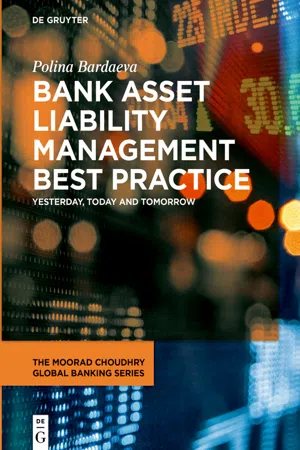
Bank Asset Liability Management Best Practice
Yesterday, Today and Tomorrow
- 169 pages
- English
- ePUB (mobile friendly)
- Available on iOS & Android
About this book
As bankers incorporate more and more complicated and precise calculations and models, a solely mathematical approach will fail to confirm the viability of their business. This book explains how to combine ALM concepts with the emotional intelligence of managers in order to maintain the financial health of a bank, and quickly react to external environment challenges and banks' microclimate changes.
ALM embraces not only balance sheet targets setting, instruments and methodologies to achieve the targets, but also the correct and holistic understanding of processes that should be set up in a bank to prove its prudency and compliance with internal and external constraints, requirements and limitations and the ongoing continuity of its operations. Bank Asset Liability Management Best Practice delves into the philosophy of ALM, discusses the interrelation of processes inside the bank, and argues that every little change in one aspect of the bank processes has an impact on its other parts. The author discusses the changing role of ALM and its historical and current concepts, its strengths and weaknesses, and future threats and opportunities.
Frequently asked questions
- Essential is ideal for learners and professionals who enjoy exploring a wide range of subjects. Access the Essential Library with 800,000+ trusted titles and best-sellers across business, personal growth, and the humanities. Includes unlimited reading time and Standard Read Aloud voice.
- Complete: Perfect for advanced learners and researchers needing full, unrestricted access. Unlock 1.4M+ books across hundreds of subjects, including academic and specialized titles. The Complete Plan also includes advanced features like Premium Read Aloud and Research Assistant.
Please note we cannot support devices running on iOS 13 and Android 7 or earlier. Learn more about using the app.
Information
Part 1: Historical Asset and Liability Management Concepts
- How have the ALM tasks and aims developed over time?
- What has triggered every change of the ALM aim?
- When and why have well-known instruments, methods, and approaches appeared?
- What is the interconnection between the ALM concepts?
- Management of ALM risks
- Setting targets for the balance sheet structure
- Defining the price benchmarks
- Allocation of financial resources between business lines
Chapter 1 Before the ALM Era
| 1950–1973 | ALM risk management | BS structure targeting | Price benchmarking | Resources allocation | |
|---|---|---|---|---|---|
| Short-term/tactical tasks | Operational liquidity management | ||||
| Cash and equivalents management | |||||
| Interbank placements | |||||
| Exchange operations | |||||
| Long-term/strategic tasks | Going concern | Liquidity risk management | Volumes planning* |
Chapter 2 Financial Turbulence
Table of contents
- Title Page
- Copyright
- Contents
- Acknowledgments
- Part 1: Historical Asset and Liability Management Concepts
- Part 2: Place of Asset and Liability Management in a Bank
- Part 3: New Trends in Banking and Challenges for ALM
- List of Abbreviations
- Index
- The Moorad Choudhry Global Banking Series